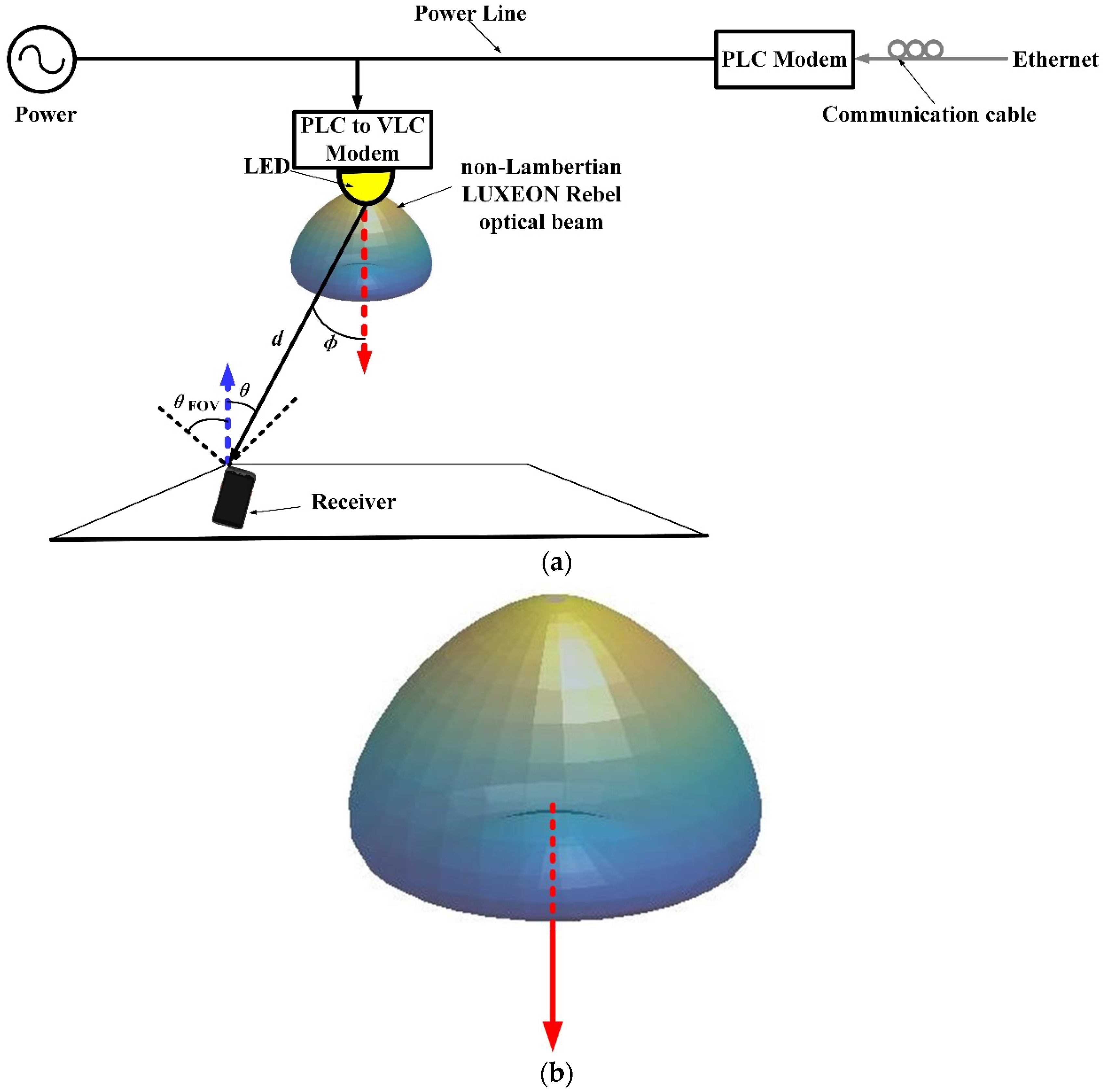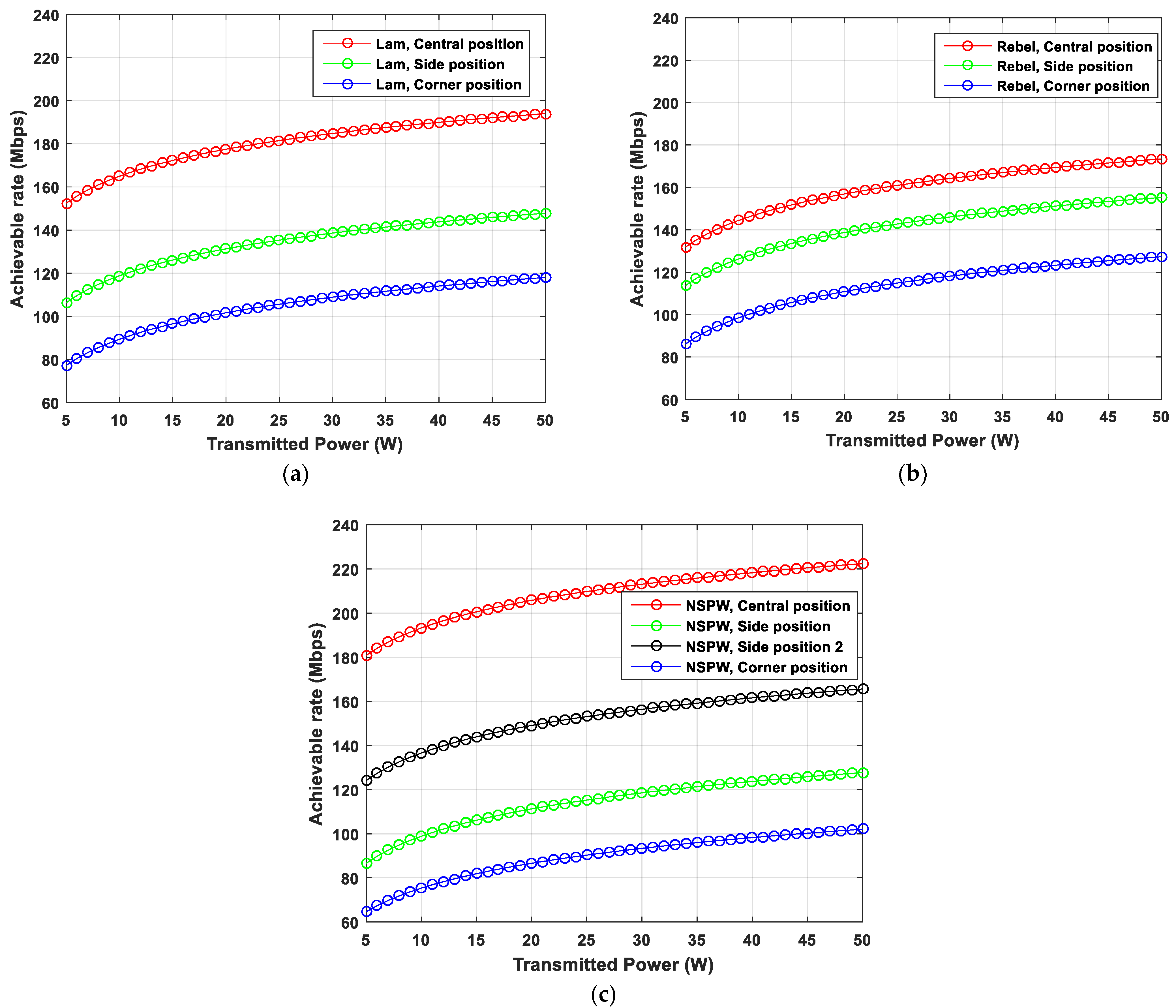Channel Characteristics of Hybrid Power Line Communication and Visible Light Communication Based on Distinct Optical Beam Configurations for 6G IoT Network
Abstract
:1. Introduction
2. Hybrid PLC and VLC Channel Based on Distinct Optical Beam Configurations
2.1. Hybrid Channel Based on Baseline Lambertian Optical Beam Configuration
2.2. Hybrid Channel Based on Distinct Non-Lambertian Optical Beam Configuration
3. Numerical Evaluation
3.1. Channel Frequency Response
3.2. Achievable Rate Performance
3.3. Effect of Azimuth Rotation
4. Conclusions
Author Contributions
Funding
Institutional Review Board Statement
Informed Consent Statement
Data Availability Statement
Conflicts of Interest
References
- Zhang, Y.; Zhang, H.; Cosmas, J.; Jawad, N.; Ali, K.; Meunier, B.; Kapovits, A.; Huang, L.-K.; Li, W.; Shi, L.; et al. Internet of radio and light: 5G building network radio and edge architecture. Intell. Converg. Netw. 2020, 1, 37–57. [Google Scholar] [CrossRef]
- Chowdhury, M.Z.; Hossan, M.T.; Islam, A.; Jang, Y.M. A comparative survey of optical wireless technologies: Architectures and applications. IEEE Access 2018, 6, 9819–9840. [Google Scholar] [CrossRef]
- Sun, S.; Yang, F.; Song, J. Sum rate maximization for intelligent reflecting surface-aided visible light communications. IEEE Commun. Lett. 2021, 25, 3619–3623. [Google Scholar] [CrossRef]
- Sun, S.; Wang, T.; Yang, F.; Song, J.; Han, Z. Intelligent reflecting surface-aided visible light communications: Potentials and challenges. IEEE Veh. Technol. Mag. 2022, 17, 47–56. [Google Scholar] [CrossRef]
- Wang, T.; Yang, F.; Song, J.; Han, Z. Dimming Techniques of Visible Light Communications for Human-Centric Illumination Networks: State-of-the-Art, Challenges, and Trends. IEEE Wirel. Commun. 2020, 27, 88–95. [Google Scholar] [CrossRef]
- Ma, S.; Zhang, F.; Zhou, F.; Wang, Y.; Li, S. Simultaneous Lightwave Information and Power Transfer in Visible Light Communication Systems. IEEE Trans. Wirel. Commun. 2019, 18, 5818–5830. [Google Scholar] [CrossRef]
- Hamza, A.S.; Deogun, J.S.; Alexander, D.R. Classification framework for free space optical communication links and systems. IEEE Commun. Surveys Tuts. 2019, 21, 1346–1382. [Google Scholar] [CrossRef]
- Ma, X.; Yang, J.G.F.; Ding, W.; Yang, H.; Song, J. Integrated Power Line and Visible Light Communication System Compatible with Multi-Service Transmission. IET Commun. 2017, 11, 104–111. [Google Scholar] [CrossRef]
- Gao, J.; Yang, F.; Ding, W. Novel Integrated Power Line and Visible Light Communication System with Bit Division Multiplexing. In Proceedings of the 2015 International Wireless Communications and Mobile Computing Conference, Dubrovnik, Croatia, 24–28 August 2015; IEEE: New York, NY, USA, 2015. [Google Scholar]
- Ma, X.; Ding, W.; Yang, F.; Yang, H.; Song, J. A Positioning Compatible Multi-Service Transmission System Based on the Integration of VLC and PLC. In Proceedings of the 2015 International Wireless Communications and Mobile Computing Conference, Dubrovnik, Croatia, 24–28 August 2015; IEEE: New York, NY, USA, 2015. [Google Scholar]
- Feng, S.; Bai, T.; Hanzo, L. Joint Power Allocation for the Multi-User NOMA-Downlink in a Power-Line-Fed VLC Network. IEEE Trans. Veh. Technol. 2019, 68, 5185–5190. [Google Scholar] [CrossRef]
- Ding, W.; Yang, F.; Yang, H.; Wang, J.; Wang, X.; Zhang, X.; Song, J. A hybrid power line and visible light communication system for indoor hospital applications. Comput. Ind. 2015, 68, 170–178. [Google Scholar] [CrossRef]
- Song, J.; Ding, W.; Yang, F.; Yang, H.; Yu, B.; Zhang, H. An Indoor Broadband Broadcasting System Based on PLC and VLC. IEEE Trans. Broadcast. 2015, 61, 299–308. [Google Scholar] [CrossRef]
- Li, D.; Hu, Y.; Zhang, G.; Pan, C.; Yang, H.; Song, J. An integrated indoor VLC+PLC system for video broadcast and positioning. In Proceedings of the 2021 International Conference Engineering and Telecommunication (En&T), Moscow, Russia, 24–25 November 2021; IEEE: New York, NY, USA, 2021. [Google Scholar]
- Yan, Y.; Ding, W.; Yang, H.; Song, J. The video transmission platform for The PLC and VLC integrated system. In Proceedings of the 2015 IEEE International Symposium on Broadband Multimedia Systems & Broadcasting, Ghent, Belgium, 3–5 April 2015; IEEE: New York, NY, USA, 2015. [Google Scholar]
- Baig, S.; Asif, H.M.; Umer, T.; Mumtaz, S.; Shafiq, M.; Choi, J.G. High data rate discrete wavelet transform-based plc-vlc design for 5G communication systems. IEEE Access 2018, 6, 52490–52499. [Google Scholar] [CrossRef]
- Liu, H.; Zhu, P.; Chen, Y.; Huang, M. Power Allocation for Downlink Hybrid Power Line and Visible Light Communication System. IEEE Access 2020, 6, 24145–24152. [Google Scholar] [CrossRef]
- Ma, H.; Lampe, L.; Hranilovic, S. Hybrid Visible Light and Power Line Communication for Indoor Multiuser Downlink. J. Opt. Commun. Netw. 2017, 9, 635–647. [Google Scholar] [CrossRef]
- Gao, S.; Zhang, J.; Song, J.; Yang, H. Random channel generator of the integrated power line communication and visible light communication. In Proceedings of the 2017 IEEE International Symposium on Power Line Communications and its Applications (ISPLC), Madrid, Spain, 3–5 April 2017; IEEE: New York, NY, USA, 2017. [Google Scholar]
- Nlom, S.; Ndjiongue, A.; Ouahada, K. Cascaded PLC-VLC Channel: An Indoor Measurements Campaign. IEEE Access 2018, 6, 25230–25239. [Google Scholar] [CrossRef]
- Nlom, S.M.; Ndjiongue, A.R.; Ouahada, K.; Ferreira, H.C.; Shongwe, T. A simplistic channel model for cascaded PLC-VLC systems. In Proceedings of the IEEE ISPLC 2017—2017 IEEE International Symposium on Power Line Communications & Its Applications, Madrid, Spain, 3–5 April 2017; IEEE: New York, NY, USA, 2017. [Google Scholar]
- Komine, T.; Nakagawa, M. Fundamental analysis for visible-light communication system using LED lights. IEEE Trans. Consum. Electron. 2004, 50, 100–107. [Google Scholar] [CrossRef]
- Moreno, I.; Sun, C.-C. Modeling the radiation pattern of LEDs. Opt. Exp. 2008, 16, 1808–1819. [Google Scholar] [CrossRef]
- Ding, J.; Chih-Lin, I.; Xu, Z. Indoor optical wireless channel characteristics with distinct source radiation patterns. IEEE Photonics J. 2016, 8, 1–15. [Google Scholar] [CrossRef]
- Zimmermann, M.; Dostert, K. A multipath model for the powerline channel. IEEE Trans. Commun 2002, 50, 553–559. [Google Scholar] [CrossRef]
- Ding, J.; I, C.-L.; Wang, J.; Yang, H. Effects of Optical Beams on MIMO Visible Light Communication Channel Characteristics. Sensors 2022, 22, 216. [Google Scholar] [CrossRef] [PubMed]






| Parameters | Values |
|---|---|
| Room size (W × L × H) | 5 × 5 × 3 m3 |
| Number of transmitter | 1 |
| Location of transmitter | (2.5, 2.5, 3) m |
| LED Lambertian index | 1 |
| LED conversion factor | 0.44 W/A |
| Photodiode responsivity | 0.30 A/W |
| Subcarrier bandwidth | 0.5 MHz |
| Number of subcarriers | 40 |
| Receiver field of view | 90° |
| Height of receiving plane | 0.85 m |
| Physical area of PD | 1.0 cm2 |
| Delay | 0.33 μs |
| Delay | 0.5 μs |
| Delay | 0.54 μs |
| Delay | 0.58 μs |
| Delay | 0.6 μs |
| Delay | 1.2 μs |
| Weighting factor | 0.54 |
| Weighting factor | 0.275 |
| Weighting factor | −0.15 |
| Weighting factor | 0.08 |
| Weighting factor | −0.03 |
| Weighting factor | −0.02 |
| Exponent of the attenuation factor k | 1 |
| Attenuation parameter | −2.1 × 10−3 |
| Attenuation parameter | 8.1 × 10−10 |
Disclaimer/Publisher’s Note: The statements, opinions and data contained in all publications are solely those of the individual author(s) and contributor(s) and not of MDPI and/or the editor(s). MDPI and/or the editor(s) disclaim responsibility for any injury to people or property resulting from any ideas, methods, instructions or products referred to in the content. |
© 2024 by the authors. Licensee MDPI, Basel, Switzerland. This article is an open access article distributed under the terms and conditions of the Creative Commons Attribution (CC BY) license (https://creativecommons.org/licenses/by/4.0/).
Share and Cite
Ding, J.; I, C.-L.; Wang, J.; Song, J. Channel Characteristics of Hybrid Power Line Communication and Visible Light Communication Based on Distinct Optical Beam Configurations for 6G IoT Network. Appl. Sci. 2024, 14, 7481. https://doi.org/10.3390/app14177481
Ding J, I C-L, Wang J, Song J. Channel Characteristics of Hybrid Power Line Communication and Visible Light Communication Based on Distinct Optical Beam Configurations for 6G IoT Network. Applied Sciences. 2024; 14(17):7481. https://doi.org/10.3390/app14177481
Chicago/Turabian StyleDing, Jupeng, Chih-Lin I, Jintao Wang, and Jian Song. 2024. "Channel Characteristics of Hybrid Power Line Communication and Visible Light Communication Based on Distinct Optical Beam Configurations for 6G IoT Network" Applied Sciences 14, no. 17: 7481. https://doi.org/10.3390/app14177481





